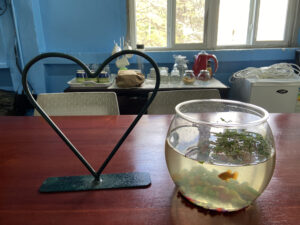I stand outside the thick gate securing the Boys Training Centre (BTC), a facility dedicated to rehabilitating boys aged 10 and older. Entry is strictly by appointment, and only when the centre’s manager, Leanna Wallace, arrives to greet me am I allowed inside.
The small reception area where I sign in and receive a visitor badge doubles as a secured space for family visits. Typically, visitors must stay on a marked path, but for this tour, I’m granted special access – guided past woodwork, auto mechanic and welding rooms where the boys receive hands-on training. Displayed around the facility are items crafted by the trainees: railings, burglar bars, ornaments and décor. Wallace and her staff proudly point them out.
The grounds are expansive and well-kept. We pass a large kitchen where three daily meals are prepared, a laundry room, and quarters labelled “House Mother,” a dedicated space for the woman who ensures the boys are dressed and ready for school.
Under Wallace’s leadership, a “House Father” role has been introduced, a paternal figure she deems essential.
In the distance, separated by a fence, a sign marks the Care and Protection Unit. Boys reside here for various reasons – some have suffered abuse, others lack family support, or their families are unwilling or unable to care for them, including in cases involving suspected disabilities. Some are admitted due to troubling behaviours, like chronic truancy or actions that fall short of criminal offences.

“Good afternoon,” a few boys greet us as they pass by. Like all Saint Lucian children, they’re on Easter break. Wallace, a trained teacher, engages them with a blend of warmth and firmness, the tone of a principal or no-nonsense parent. Throughout our tour, she refers to them as “my boys.”
They head toward the Care and Protection Unit, but visitors aren’t permitted beyond its gate.
I learn that boys classified as “young criminal offenders”, a minority within the facility, live in a separate building. However, during recreation, training and classes, both groups interact. When I ask about this integration, a point of concern for outsiders, Wallace responds emphatically:
“That’s a misconception of most Saint Lucians – that they all stay together and become the same. That’s not true.”
“If you’re in your community …[and] your mother raised you well [but] your neighbour, the mother did not raise them well, as children, you don’t judge, you play together. When you get older, parents try to instill that ‘one is bad’, but children, they play [together],” she explains.
She draws a parallel to school: “When you go to secondary school … you sit by a child that probably their parents are delinquents and they are delinquents as well, but you all play together as classmates. Do you all live in the same physical space? No.”
Later, Wallace expands on rehabilitation challenges, explaining how isolated incidents have skewed public perception, creating a stigma that unfairly shadows boys who successfully reintegrate into society. She also touches on the social circumstances that often undermine progress after their release, and, in rare cases, how some are transferred to the Bordelais Correctional Facility.

Continuing the tour, we visit the sick bay and counselling area at the far end of the property. Along the way, we pass a small banana field, chicken coops and rabbit pens. Wallace shares plans to expand agricultural projects, though a dilapidated hydroponics greenhouse stands unused, a relic of a past initiative.
The counselling rooms are spacious and welcoming, furnished with couches and private spaces. A counsellor explains that sessions are held regularly, including family counselling for those with involved relatives. It’s also where the boys make supervised phone calls.
As we cross the facility’s grassy lawn toward Wallace’s office for our interview, we pass the construction site of the new Gros Islet Police Headquarters, rising beside the centre. Wallace welcomes the development, hopeful it will strengthen ties with law enforcement.
She also points out the rundown sports court, another area she hopes to refurbish. The perimeter fence, too, is slated for replacement to bolster security. These upgrades, she notes, will be funded by the $167 000 allocated to the BTC in the 2025–2026 budget.
While government support covers physical rehabilitation materials, Wallace emphasises that the needs are vast. Additional donations and external partnerships would be invaluable.
“Government [is] always willing to give their resources in terms of these things,” she says. “What you need is the human resources; teachers to teach these things, the space to teach these things. And I think as government agencies, if we had more collaboration, we’d have better.”
As we walk towards her office, and in conversations with staff, I get a clearer picture of the centre’s challenges: navigating the complexities of rehabilitation and helping the boys reintegrate into Saint Lucia’s tight-knit, sometimes unforgiving social fabric.
- Part 2 will be published in next week’s e-paper.




